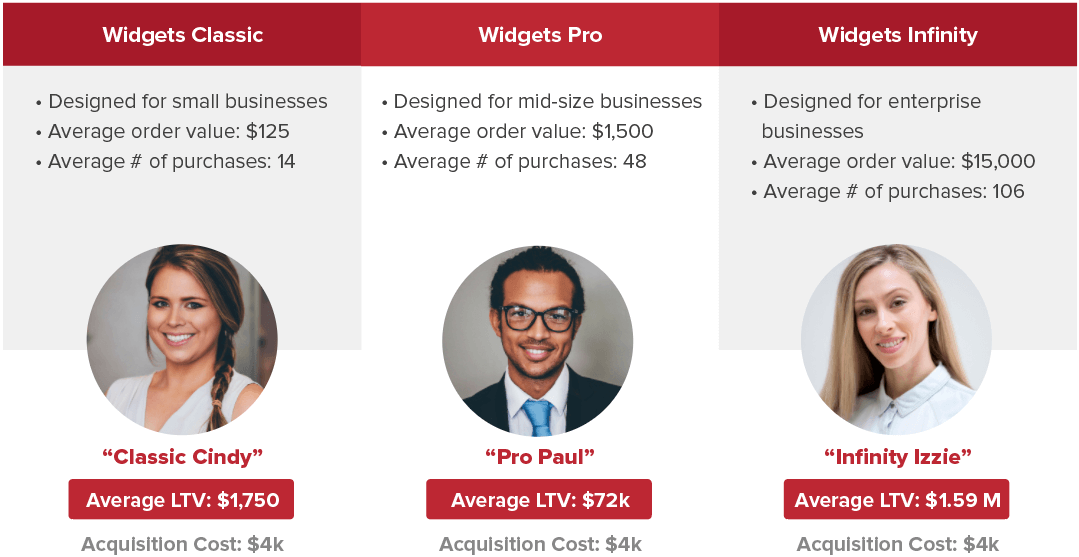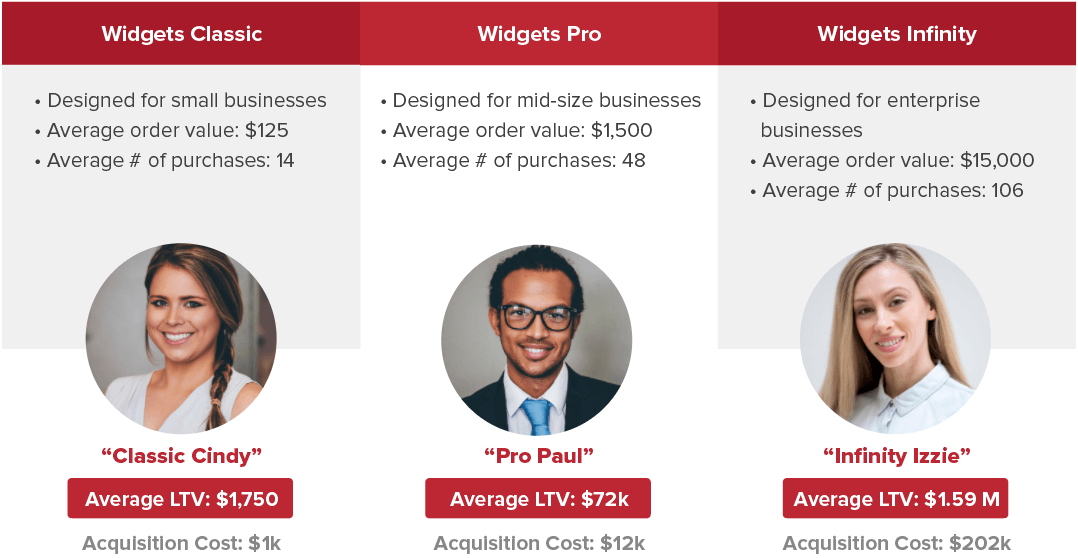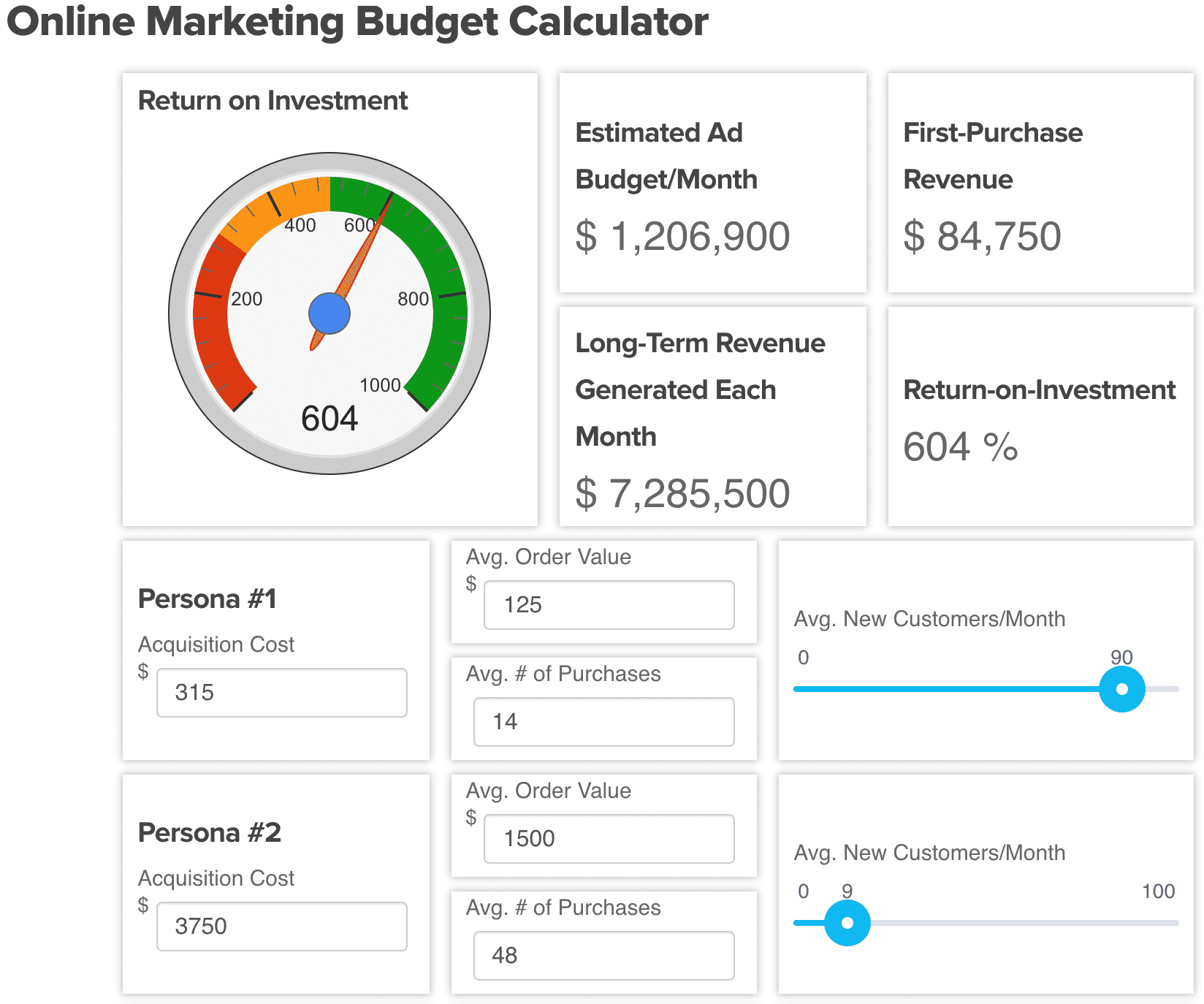What Should Your Facebook Ads Budget Be Next Year? [CALCULATOR]
by Aden Andrus • October 2, 2019
With the end of the year rapidly approaching, most businesses are actively trying to figure out next year’s marketing strategy. And, with Facebook Ads accounting for around 20% of all digital ad spend, odds are that picking the right Facebook Ads budget is a big part of that discussion.
But how do you pick the right Facebook Ads budget?
On the surface, this might seem like a fairly simple question to answer. I mean, you could just go with the numbers. After all, 25% of online marketing spend goes towards social media advertising, so you could just take your online marketing budget and assign a quarter of it to Facebook Ads.
But…while that’s certainly a simple approach, it doesn’t really guarantee that you’ll get the most bang for your buck. If you want a Facebook Ads budget that actually delivers, you know…meaningful results for your company, you’ll need to think about things a bit harder.
The good news is, picking the right Facebook Ads budget—or marketing budget in general—doesn’t have to be a guessing game. With a little research and a few calculations (don’t worry, I’ve included a calculator in this article to help with that), choosing your Facebook Ads budget will be a breeze!
Getting Started
Before you can pick your Facebook Ads budget, there’s an important question you need to answer: How much money do you want to make from Facebook Ads?
The point of Facebook marketing is to generate profitable revenue for your company. So, if you don’t know how much you want to make from Facebook Ads, it’s kind of tricky to put together a budget.
The only problem is, most Facebook Ads budgets (and marketing budgets in general) aren’t based on how much revenue the business wants to drive. Instead, they’re focused on other metrics, like engagement rates, cost-per-click (CPC) or even cost-per-conversion.
While none of these metrics are bad—and they’re certainly all worth tracking—they don’t tell you a whole lot about how well your Facebook Ads campaigns are achieving their primary goal: driving profitable revenue.
Why Your Revenue and ROI Goals Matter
When your Facebook Ads budget is based on how many clicks you can drive or “likes” you can get, it usually doesn’t do a whole lot for your business. You can promote a funny video and get cheap likes or a mega sale and get clicks. But revenue? Revenue typically takes a lot more money and effort.
Unfortunately, according to results from a survey we ran a little while back, only 41% of businesses take revenue or return-on-investment (ROI) into account when choosing their Facebook Ads budgets. In contrast, conversion rates play a major role in budget decisions for 60-80% of businesses.
Here are some additional results from the survey:
![Does Your Online Marketing Budget Really Make Sense [INFOGRAPHIC] | Disruptive Advertising](https://wp.disruptiveadvertising.com/wp-content/uploads/2016/11/marketing-budget-infographic-small.jpg)
While these figures are a tad dismal, they’re actually good news for you.
Since most of your competitors are effectively picking their Facebook Ads budget out of a hat, if you can come up with a more rational, ROI-driven goal, you can get a whole lot more out of Facebook Ads than the competition.
So, before we move on, make sure you know what your revenue and ROI goals are for your Facebook Ads. You may need to do a little research to identify the right goal, but make sure that you have a clear revenue goal before you try to figure out your Facebook Ads budget.
Defining Your Customers
Now, it may seem a bit odd to talk about defining your customers in an article on budgeting, but hear me out. Your buyer personas are actually the secret to creating an effective Facebook Ads budget.
Understanding Your Buyer Personas
To show you how this works, let’s run through a little hypothetical scenario. In this scenario, we’ll pretend that you’re the marketing director for ACME Widgets. Your business manufactures—not unsurprisingly—widgets, but these aren’t just any old widgets. You sell the world’s very best widgets, so your average customer lifetime value (LTV) is $24,000.
While planning next year’s Facebook Ads budget, you take a look at this year’s performance and discover that you spent over 40% of your budget on a campaign that produced less than 1% of your sales. Given your cost-per-sale (aka, acquisition cost) of $4,000, you’ve just uncovered a colossal waste of money…right?
I mean, it’s just simple math. If 40% of your budget is producing less than 1% of your sales, you should be able to cut your Facebook Ads budget by 40% next year without adversely affecting sales. That’s a huge win!
But, you’re a smart marketer. So, you decide to take a closer look before you make any final decisions. You see, ACME has three primary types of buyers (aka, “buyer personas”):

As you dig into that oh-so-expensive-and-unprofitable Facebook campaign, you discover something surprising: all of the sales from that campaign are “Infinity Izzies”. In fact, 59% of your new revenue from Facebook comes from that single campaign.
Getting rid of that campaign would have reduced your ad spend by 41%…and wiped out most of your Facebook Ads revenue.
This is why it’s so important to understand your audience. Different buyer personas respond to different types of ads and campaigns. It’s probably going to take a very different approach and a lot more effort and money to get an “Infinity Izzie” to buy than a “Classic Cindy”.
Budgeting for Your Personas
To create a truly effective Facebook Ads budget, you have to know more than your revenue goal and average cost-per-sale. You need to take a look at your different buyer personas and their specific acquisition costs.
Returning to our story, after seeing how much revenue that campaign was bringing in, you decide to set different acquisition cost goals for each of ACME Widget’s buyer personas:

All of a sudden, your marketing goals become much clearer. You can afford to spend a lot more on a new “Infinity Izzie” customer than you ever would on a “Classic Cindy”. Your whole marketing strategy for “Infinity Izzies” is probably very different than it is for “Classic Cindy’s”. That’s something you have to account for in your Facebook Ads budget.
Are you starting to see why it’s so important to account for your buyer personas in your budgeting?
Sadly, while most marketers know what buyer personas are, only about 30% are actually using them in a meaningful way. Is it any wonder that most Facebook Ads budgets feel like they’re pulled out of a hat?
If you’re not picking a Facebook Ads budget based on your target customers and what they’re worth to your business, you aren’t picking a very effective budget. You might overspend, you might underspend, but don’t be surprised if your Facebook Ads budget just doesn’t seem to work out right next year.
Creating Your Facebook Ads Budget
Once you know what your revenue goal is and what you can afford to spend to acquire a new customer from each of your buyer personas, the rest really is just simple math.
To help you out, here’s a free calculator you can use to determine the monthly Facebook Ads budget your business needs to achieve its goals:
All you have to do is enter your target acquisition cost, average order value (or service contract price, for a service business) and the average number of purchases for each buyer persona. Then, using the slider on the right, you can adjust how many new customers you would like each month from that buyer persona.
You can do this for up to 4 buyer personas, but if you want to use fewer personas than that, simply drag the sales bars to zero for any buyer persona slots you aren’t using.
The calculator will automatically show you what your monthly Facebook Ads budget will need to be to achieve your goals, along with how much initial and long-term (aka, LTV) revenue you can expect from your investment. Pretty handy, eh?
By the way…
If you’re having a hard time figuring out your marketing budget, why not let us help? Click here to send us a message and we’d be happy to jump on a call and help you figure out how to win at Facebook Advertising.
Of course, if you want to create your own spreadsheet that you can manipulate however you want, that’s an option, too. Here’s what you’ll need to do to figure out your Facebook Ads budget.
Step 1
First, you need to break down your Facebook revenue goal based on the percentage of your revenue that you want to come from each of your buyer personas.
For example, if ACME wanted to make $2,425,500 a month, they might break things down like this:
- “Classic Cindy” sales will generate 6% of revenue goal ([$2,425,500] x [0.06] = $157,500)
- “Pro Paul” sales will generate 27% of revenue goal ([$2,425,500] x [0.27] = $648,000)
- “Infinity Izzie” sales will generate 67% of revenue goal ([$2,425,500] x [0.67] = $1,590,000)
This gives ACME a clear revenue goal for each buyer persona that they can use to determine their overall marketing budget.
Step 2
Next, you need to figure out how many new customers you need from each buyer persona. To figure that out, simply divide the revenue goal you picked for each buyer persona by the average lifetime value of that persona.
In ACME’s case, that would look like this:
- “Classic Cindy”: [$157,500 revenue] / [$1,750 revenue per customer] = 90 customers
- “Pro Paul”: [$648,000 revenue] / [$72,000 revenue per customer] = 9 customers
- “Infinity Izzie”: [$1,590,000 revenue] / [$1,590,000 revenue per customer] = 1 customer
This calculation allows you to figure out what your sales goals are, which is ultimately the key to figuring out your Facebook Ads budget.
Step 3
Finally, take the number of customers you want to acquire from each buyer persona and multiply that by your target acquisition cost for each buyer persona. As a general rule, we recommend choosing a target acquisition cost that is less than 1/3rd of a new customer’s LTV, but you can choose whatever acquisition cost makes sense for your business.
Again, for ACME, this is how things might shake out:
- “Classic Cindy”: [90 customers] x [$1,000 per customer] = $90,000 of ad spend
- “Pro Paul”: [9 customers] x [$12,000 per customer] = $108,000 of ad spend
- “Infinity Izzie”: [1 customer] x [$202,000 per customer] = $202,000 of ad spend
This calculation tells you how much you’ll need to spend on Facebook Ads to achieve your goal. For example, given these numbers, ACME would have to spend $400,000 to produce $2,425,500 in new lifetime revenue.
You can use this formula to calculate your monthly Facebook Ads budget, yearly budget or any other budget you’re interested in.
If the number seems a bit steep, remember, it doesn’t matter how much you spend on Facebook Ads as long as the net result is profitable for your business (assuming, of course, that you can handle the volume). If your ads are delivering results that are consistent with your projections, the sky’s the limit!
Conclusion
Contrary to what most business owners and marketers seem to believe, you can’t base your Facebook Ads budget on instinct. A good Facebook Ads budget is goal- and data-driven. It takes a lot more thought than just picking a number at random and hoping it works.
But, if you use the approach we’ve discussed in this article, you should be able to create a Facebook Ads budget that will actually produce meaningful results for your business.
By the way, if you’re still feeling confused or overwhelmed, just reach out to us here! We’d love to help you figure out how to make the most of your Facebook Ads. If you’d like some help, why not let us audit your Facebook account for free?
What do you think of this approach? Does it make sense to you? Any Facebook budgeting tips you’d like to share? Leave your thoughts in the comments below.






